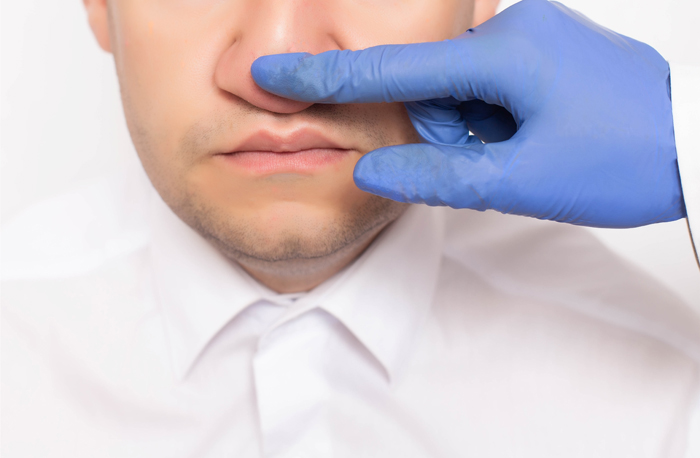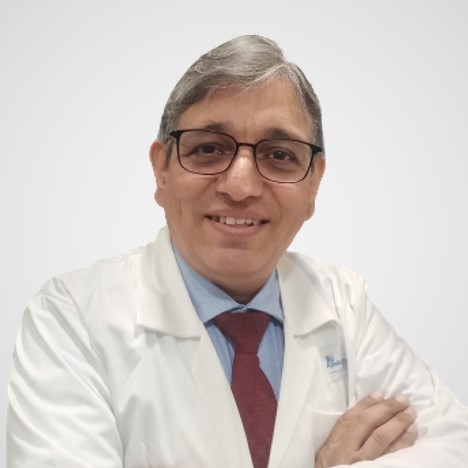Saddle Nose Deformity Treatment in Chunni-ganj, Kanpur
A nasal deformity is an abnormality in the structure and the appearance of the nose. The functions of the nose get affected by it. These are relatively common.
Nasal deformities can be classified into two types -
- Cosmetic: These types of nasal deformities affect the shape and structure of the nose.
- Functional: These types of nasal deformities affect the functions of the nose, which can cause breathing problems, snoring, sinuses, and an impaired sense of smell.

Types of Nasal Deformities
- Cleft palate: It affects more than just the nose and is a type of congenital nasal deformity.
- Nasal/dorsal hump: Usually common in families, it can also occur due to trauma. It occurs due to cartilage or excess bone, depending on where in the nose it occurs.
- Saddle nose: It can occur due to several reasons, such as cocaine abuse, certain diseases, or trauma. Also known as "boxer's nose", this is a depression in part of the nasal bridge.
- Swollen turbinate: Turbinate helps clear and humidify the air we breathe in. They can affect breathing if swollen.
- Enlarged adenoids: One may experience sleep apnea i.e blockage of the airway due to the enlargement of the lymph glands at the back of the nose.
- Deviated septum: The cartilage that separates your right and left nasal passages is displaced to one side in this condition.
Symptoms of Nasal Deformities
Whether a nasal deformity is cosmetic or functional, its most common symptoms include:
- Difficulty in breathing
- Snoring
- Blockage of one or both nostrils
- Nose bleeding
- Facial pain
- Sinuses problem
- A diminished sense of smell
Causes of Nasal Deformities
Nasal deformities can be caused by congenital problems (present at birth) or due to an injury. Other common causes of nasal deformities can include:
- Nasal trauma
- Nasal surgery
- Connective tissue disorder
- Medical conditions such as Wegener's granulomatosis, sarcoidosis, and polychondritis
- Weakening of nasal structure
When to See a Doctor?
When your nasal deformities start affecting your quality of life, you should see a doctor.
- If you're not happy with your nose structure and it is keeping your morale down and your self-confidence, then it's time to consult a doctor.
- If your nostrils are blocked and you find difficulty in breathing, these issues can interrupt your sleep at night. It can cause you to breathe through your mouth.
Request an appointment at Apollo Spectra Hospitals, Kanpur
Call 1860-500-2244 to book an appointment
Treatment for Nasal Deformities
Treatment for nasal deformities at Apollo Spectra, Kanpur, includes medications for managing the symptoms and surgery to repair the structural fault.
- Medication -
- Analgesic: These medications help treat headaches and sinus pain.
- Decongestants: These drugs relieve congestion and reduce the swelling of the nasal tissues.
- Antihistamines: These are generally used for allergies but antihistamines can also help reduce congestion and dry up a runny nose.
- Steroid sprays: These medications can reduce inflammation of the nasal tissue.
- Surgery -
- Rhinoplasty: This is a surgery performed at Apollo Spectra, Kanpur, for reshaping the nose for an improved look and better nasal functioning.
- Septoplasty: This surgery is performed at Apollo Spectra, Kanpur, to straighten the septum, which is cartilage and bone, to separate the two nostrils.
- Closed reduction: This is a procedure performed to repair a broken nose without surgery.
Conclusion
Treatment of nasal deformities is a challenging attempt, because of the variety and complexity of the traumas. Nasal deformities are treated by an otolaryngologist, who has in-depth knowledge of nose functionalities and their anatomy. Usually, rhinoplasty is performed by a specialist in reconstructive, aesthetic, and plastic surgery, who has specialized in nasal traumas.
The most common nasal deformity is broad nasal dorsum
It takes approximately 6 weeks for most patients to heal the bone of the nose after the surgery.
Yes, it can cause long-term problems., leading to infection of the nose and sinuses.
Symptoms
Our Doctors
DR. SANJEEV KUMAR
MBBS,MS...
| Experience | : | 34 Yeras Experience |
|---|---|---|
| Speciality | : | ENT, Head and Neck S... | Location | : | Chunni Ganj |
| Timings | : | Available by prior a... |
DR. LAXMI TANDON
BDS...
| Experience | : | 16 Yeras Experience |
|---|---|---|
| Speciality | : | Dental and Maxillofa... | Location | : | Chunni Ganj |
| Timings | : | Mon - Sat : 9:00 AM ... |
DR. ALOK GUPTA
MD (Gen Medicine), D...
| Experience | : | 33 Yeras Experience |
|---|---|---|
| Speciality | : | General Surgery & Ga... | Location | : | Chunni Ganj |
| Timings | : | Mon - Sat : 10:00 AM... |
DR. ARUN KHANDURI
MBBS, MD (Gen. Med),...
| Experience | : | 36 Yeras Experience |
|---|---|---|
| Speciality | : | General Surgery & Ga... | Location | : | Chunni Ganj |
| Timings | : | Mon - Sat : 10:00 AM... |
DR A P SINGH
MBBS,DLO...
| Experience | : | 14 Yeras Experience |
|---|---|---|
| Speciality | : | ENT, Head and Neck S... | Location | : | Chunni Ganj |
| Timings | : | Available by prior a... |
DR. KARTIK AGARWAL
MBBS, MD - General M...
| Experience | : | 6 Yeras Experience |
|---|---|---|
| Speciality | : | Gastroenterology... | Location | : | Chunni Ganj |
| Timings | : | Mon to Sat : 5:00 PM... |
Our Top Specialities
NOTICE BOARD
CONTACT US
CONTACT US
 Book Appointment
Book Appointment








.svg)
.svg)
.svg)
.svg)








